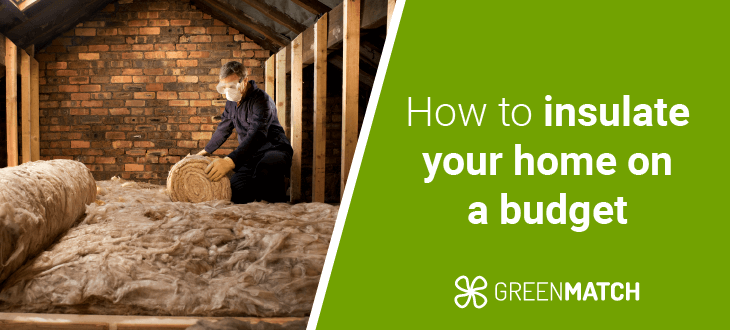- GreenMatch
- Blog
- How to insulate your home on a budget
How to insulate your home on a budget


Over the next few months, the UK will see temperatures regularly dropping below zero. This is a huge worry for millions of households who can’t afford to frequently heat their homes. There is, however, an easy way to keep your home warm on a budget by using simple insulation techniques.
Improving insulation makes a home feel warmer without having to turn on the radiator. It can prevent heat from escaping and cold outside air from entering a property. It’s also more environmentally friendly than central heating and can save you money on energy bills.
To help you stay warm this winter, our insulation expert, Joshua Houston, has shared five top tips below, on how to insulate your home on a budget.
1: Fit pipe and loft insulation
One quick and easy way to begin insulating your home is to add sleeves to your external pipes, to prevent them from getting too cold. Frozen pipes can cause heating systems to break down, losing efficiency and wasting more energy.
As well as adding insulation to pipework, you should also assess areas particularly vulnerable to the cold like your loft, crawlspaces and underneath floorboards. Loose-fill insulation is perfect for this and is an affordable option, with a large bag costing around £30. It’s easy to place in the smaller areas of a loft and does a good job of keeping the cold out of your home, and the heat in.
2: Make use of curtains
Windows are a common place for the outside cold to get into your home, this is because small gaps can appear in the surround and sealant which can let in air. Always close your curtains, particularly at night, as this is when it becomes coldest. This is a simple way for you to provide yourself with an extra layer of warmth, as it can create a form of insulation between your window and curtain.
If you have the spare funds, consider investing in heavy curtains. These will do an even better job of keeping that unwanted cold away and can be much cheaper than other alternatives.
3: Add a rug
Your floor is another area of your home where heat can be lost and make you feel chilly - this is particularly true for those with hardwood flooring. To tackle this issue, try adding rugs, as they can provide a layer of insulation between a bare floor and the room above. It will also make your home feel cosy and a more pleasant place to walk around (especially in bare feet!).
4: Search for cracks and gaps
A common reason for properties having poor insulation, and ultimately losing heat, is hidden cracks and gaps that you may be unaware of. Give your home a thorough inspection, and take a particularly close look at your loft and garage areas, as these are vulnerable.
Cracks and gaps can be caused by pests, who use your home as a shelter for their nests. Ageing, weathering and general wear and tear can also cause sealant or surrounds on windows and doors to split. Fill in any gaps that you find with a gap filler, or block areas with weather stripping. However, if you find a larger area of damage you should consider a professional repair.
4: Close your internal doors
Closing your outside doors might be an obvious tip, but it’s also important to keep your internal doors closed. If your household often gathers in one room in the evening, such as the kitchen or living room, this means you only have to heat a small area of your home. Closing the doors will keep the heat in and the cold out.
Joshua Houston, Insulation Expert at GreenMatch:
‘’Staying warm during the colder months is on a lot of people's minds at the moment. With the soaring cost of heating in the past few years, many have had to think outside the box in order to reduce their outgoings and keep warm.
These tips will not only save you money and keep you warm, but they’re also beneficial for the environment. You will reduce your carbon footprint drastically without realising.’’

Joshua is a GreenMatch writer who thrives at sharing useful advice on how to save people money on their household costs and making their lives more sustainable.
We strive to connect our customers with the right product and supplier. Would you like to be part of GreenMatch?

